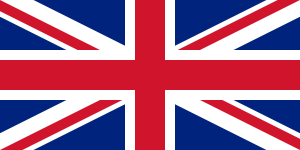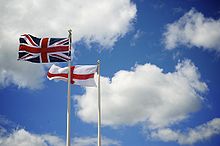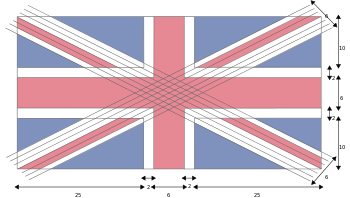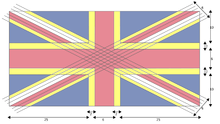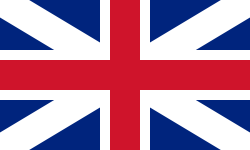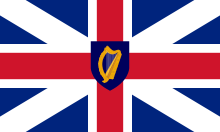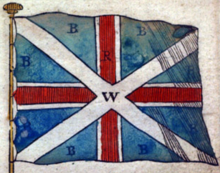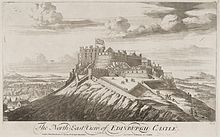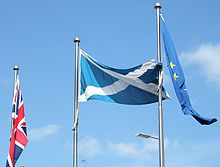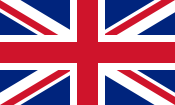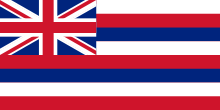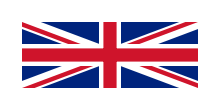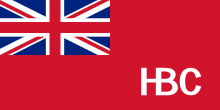
Union Jack
Background to the schools Wikipedia
Arranging a Wikipedia selection for schools in the developing world without internet was an initiative by SOS Children. A quick link for child sponsorship is http://www.sponsor-a-child.org.uk/
The Union Flag, commonly also known as the Union Jack, is the flag of the United Kingdom, as well as a flag with an official or semi-official status in some Commonwealth realms; for example, it is known by law in Canada as the Royal Union Flag. It is also used as an official flag in some of the smaller British overseas territories. The Union Flag also appears in the canton (upper left-hand quarter) of the flags of several nations and territories that were former British colonies.
The origins of the flag date back to 1603, when James VI of Scotland inherited the English and Irish thrones (as James I), thereby uniting the crowns of England, Scotland and Ireland in a personal union (which remained separate states). On 12 April 1606, a new flag to represent this regal union between England and Scotland was specified in a royal decree, according to which the flag of England (a red cross on a white background, known as St George's Cross), and the flag of Scotland (a white saltire on a blue background, known as the Saltire or St Andrew's Cross), would be joined together, forming the flag of Great Britain and first union flag.
The current design dates from the Union of Great Britain and Ireland in 1801. The flag combines aspects of three national flags: the red cross of Saint George, the red saltire of Saint Patrick's Flag, and the Flag of Scotland.
Terminology
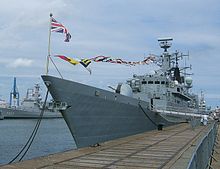
The terms Union Flag and Union Jack are both historically correct for describing the de facto national flag of the United Kingdom. Whether to call it the "Union Flag" or the "Union Jack" is a matter of debate by many. According to the Flag Institute, the vexillological organisation for the United Kingdom, "the national flag of the United Kingdom, the Crown Dependencies and Overseas Territories is the Union Flag, which may also be called the Union Jack." The Institute also notes:
It is often stated that the Union Flag should only be described as the Union Jack when flown in the bows of a warship, but this is a relatively recent idea. From early in its life the Admiralty itself frequently referred to the flag as the Union Jack, whatever its use, and in 1902 an Admiralty Circular announced that Their Lordships had decided that either name could be used officially. In 1908, a government minister stated, in response to a Parliamentary question, that "the Union Jack should be regarded as the National flag".
Nevertheless, the term "Union Flag" is used in King Charles's 1634 proclamation:
... none of Our Subjects, of any of Our Nations and Kingdoms shall from henceforth presume to carry the Union Flag in the Main top, or other part of any of their Ships (that is) St Georges cross and St Andrew's Cross joined together upon pain of Our high displeasure, but that the same Union Flag be still reserved as an ornament proper for Our own Ships and Ships in Our immediate Service and Pay, and none other."—Proclamation appointing the Flag, as well for Our Navy Royal as for the Ships of Our Subjects of South and North Britain – 5 May 1634
and in King George III's proclamation of 1 January 1801 concerning the arms and flag of the United Kingdom of Great Britain and Ireland:
And that the Union Flag shall be Azure, the Crosses Saltires of St. Andrew and St. Patrick Quarterly per Saltire, counterchanged Argent and Gules; the latter fimbriated of the Second, surmounted by the Cross of St. George of the Third, fimbriated as the Saltire : ...—A Proclamation Declaring His Majesty's Pleasure concerning the Royal Style and Titles appertaining to the Imperial Crown of the United Kingdom of Great Britain and Ireland, and its Dependencies, and also the Ensigns, Armorial Flags, and Banners thereof"
When the first flag representing Britain was introduced on the proclamation of King James I in 1606, it became known simply as "the British flag" or "the flag of Britain". The royal proclamation gave no distinctive name to the new flag. The word "jack" was in use before 1600 to describe the maritime bow flag. By 1627 a small Union Jack was commonly flown in this position. One theory goes that for some years it would have been called just "the Jack", or "Jack flag", or "the King's Jack", but by 1674, while formally referred to as "His Majesty's Jack", it was commonly called the Union Jack, and this was officially acknowledged.
Amongst the proclamations issued by King George III at the time of the Union of 1801 was a proclamation concerning flags at sea, which referred to "Our Flags, Jacks, and Pendants" and forbade merchant vessels from wearing "Our Jack, commonly called the Union Jack" nor any pendants or colours used by the King's ships. In contrast, the King's proclamation of the same day concerning the arms and flag of the United Kingdom, not colours at sea, called the new flag "the Union Flag".
The size and power of the Royal Navy internationally at the time could also explain why the flag was named the "Union Jack"; considering the navy was so widely utilised and renowned by the United Kingdom and colonies, it is possible that the term "Jack" occurred because of its regular use on all British ships using the "Jack Staff" (a flag pole attached to the bow of a ship). The term 'Union Jack' possibly dates from Queen Anne's time (r. 1702–14), but its origin is uncertain. It may come from the 'jack-et' of the English or Scottish soldiers, or from the name of James I who originated the first union in 1603. Even if the term "Union Jack" does derive from the jack flag, after three centuries, it is now sanctioned by use and has appeared in official use, confirmed as the national flag by Parliament and remains the popular term.
The authoritative A Complete Guide to Heraldry by Arthur Charles Fox-Davies uses the term Union Jack.
Design
Specification
The Union Flag is normally twice as long as it is wide, a ratio of 1:2. In the United Kingdom land flags are normally a ratio of 3:5; the Union flag can also be made in this shape, but is 1:2 for most purposes. Flags that have the Union Flag in the canton should always be 1:2 to preserve the square fly area.
The three component crosses that make up the Union Flag are sized as follows:
- The red St George's Cross width is 1⁄5 of the flag's height with a 1⁄15 flag height fimbriation
- The white diagonal St Andrew's Cross width is 1⁄15 of the flag's height and the broader white diagonal's width is 1⁄10 of the flag's height
- The red diagonal St Patrick's Cross width is 1⁄15 of the flag's height and the narrow white diagonal's width is 1⁄30 of the flag's height
Another way of looking at it is that the white diagonal St Andrew's Cross and the red diagonal St Patrick's Cross sit side-by-side along the centre-lines of the diagonals. They each have a width of 1⁄15 of the flag's height with a 1⁄30 flag height fimbriation. The crosses are slightly pinwheeled with St Andrew's Cross leading in the clockwise direction.
The centre-lines of the diagonals must meet in the centre (as shown on the diagram). The three crosses retain their thickness whether they are shown with a ratio of 3:5 or 1:2
Colours
The colour specifications for the colours Union Flag (Royal) Blue, Union Flag Red and White are:
| Scheme | Blue (D) | Red (H) | White (J) | General Note: The colour schemes are not all congruent. This is due to different specifications for different types of media (for example, screen and print) * Not official; these are Wikimedia Commons' own conversions of the Pantone. |
|---|---|---|---|---|
| Pantone (paper) | 280 C | 186 C | Safe | |
| Web-Safe Hex | #003399 | #CC0000 | #FFFFFF | |
| 8711D | 8711 | 8711J | ||
| NSN | 8305.99.130.4580 | 8305.99.130.4584 | 8305.99.130.4585 | |
| CMYK | 100.72.0.18.5 | 0.91.76.6 | 0.0.0.0 | |
| RGB ( Hex)* | 0, 36, 125 (#00247D) | 207, 20, 43 (#CF142B) | 255, 255, 255 (#FFFFFF) |
Flying
The flag does not have reflection symmetry due to the slight pinwheeling of the St Patrick's and St Andrew's crosses, technically the counterchange of saltires. Thus, there is a right side up. Although the original specification of the Union Flag in the Royal Proclamation of 1 January 1801 did not contain a drawn pattern nor express which way the saltires should lie; they were simply "counterchanged" and the red saltire fimbriated, nevertheless, a convention was soon established which accords most closely with the description.
When statically displayed, the hoist is on the observer's left. To fly the flag correctly, the white of St Andrew is above the red of St Patrick in the upper hoist canton (the quarter at the top nearest to the flag-pole). This is expressed by the phrases wide white top and broad side up.
Interestingly, the first drawn pattern for the flag was in a parallel Proclamation of 1 January 1801 concerning civil naval ensigns, which drawing shows the red ensign (also to be used as a red jack by privateers). As it appears in the London Gazette, the broad stripe is at the top of the saltires on both sides, hoist and fly. That is not in accordance with the specification "counterchanged" as heraldry understands it.
It is often stated that a flag upside down is a form of distress signal or even a deliberate insult. In the case of the Union Flag, the difference is subtle and is easily missed by the uninformed. It is often displayed upside down inadvertently—even on commercially-made hand waving flags.
On 3 February 2009, the BBC reported that the flag had been inadvertently flown upside-down by the UK government at the signing of a trade agreement with Chinese premier Wen Jiabao. The error had been spotted by readers of the BBC news website who had contacted the BBC after seeing a photograph of the event.
History
In 1603, James VI of Scotland inherited the English and Irish thrones (as James I), thereby uniting the crowns of England, Scotland and Ireland in a personal union (which remained separate states). On 12 April 1606, a new flag to represent this regal union between England and Scotland was specified in a royal decree, according to which the flag of England (a red cross on a white background, known as St George's Cross), and the flag of Scotland (a white saltire on a blue background, known as the Saltire or St Andrew's Cross), would be joined together, forming the flag of Great Britain and first union flag:
By the King: Whereas, some differences hath arisen between Our subjects of South and North Britaine travelling by Seas, about the bearing of their Flagges: For the avoiding of all contentions hereafter. We have, with the advice of our Council, ordered: That from henceforth all our Subjects of this Isle and Kingdome of Great Britaine, and all our members thereof, shall beare in their main-toppe the Red Crosse, commonly called St George's Crosse, and the White Crosse, commonly called St Andrew’s Crosse, joyned together according to the forme made by our heralds, and sent by Us to our Admerall to be published to our Subjects: and in their fore-toppe our Subjects of South Britaine shall weare the Red Crosse onely as they were wont, and our Subjects of North Britaine in their fore-toppe the White Crosse onely as they were accustomed.
This royal flag was, at first, to be used only at sea on civil and military ships of both England and Scotland, whereas land forces continued to use their respective national banners. In 1634, King Charles I restricted its use to the royal ships. After the Acts of Union 1707, the flag gained a regularised status as "the ensign armorial of the Kingdom of Great Britain", the newly created state. It was then adopted by land forces as well, although the blue field used on land-based versions more closely resembled that of the blue of the flag of Scotland.
Various shades of blue have been used in the Saltire over the years. The ground of the current Union Flag is a deep " navy" blue ( Pantone 280), which can be traced to the colour used for the Blue Ensign of the Royal Navy's historic "Blue Squadron". (Dark shades of colour were used on maritime flags on the basis of durability.) In 2003 a committee of the Scottish Parliament recommended that the flag of Scotland use a lighter " royal" blue, (Pantone 300). (The Office of the Lord Lyon does not detail specific shades of colour for use in heraldry.)
A thin white stripe, or fimbriation, separates the red cross from the blue field, in accordance with heraldry's rule of tincture where colours (like red and blue) must be separated from each other by metals (like white, i.e. argent or silver). The blazon for the old union flag, to be compared with the current flag, is Azure, the Cross Saltire of St Andrew Argent surmounted by the Cross of St George Gules, fimbriated of the second.
Wales had no explicit recognition in the Union Flag as it had been a part of the Kingdom of England since being annexed by Edward I of England in 1282 and its full integration by the Laws in Wales Acts 1535–1542, and was therefore represented by the flag of England.
The Kingdom of Ireland, which had existed as a personal union with England since 1541, was likewise unrepresented in the original versions of the Union Flag. However, the flag of The Protectorate from 1658 to 1660 was inescutcheoned with the arms of Ireland. These were removed after the Restoration, supposedly because Charles II disliked them.
The original flag appears in the canton of the Commissioners' Ensign of the Northern Lighthouse Board. This is the only contemporary official representation of the pre-1801 Union Flag in the United Kingdom and can be seen flying from their George Street headquarters in Edinburgh.
This version of the Union Flag is also shown in the canton of the Grand Union Flag (also known as the Congress flag, the First Navy Ensign, the Cambridge Flag, and the Continental Colours), the first widely used flag of the United States, slowly phased out after 1777.
Lord Howe's action, or the Glorious First of June, painted in 1795, shows a Union flying from HMS Queen Charlotte on the " Glorious First of June" 1794. The actual flag, preserved in the National Maritime Museum, is a cruder approximation of the proper specifications; this was common in 18th and early 19th-century flags.
The flag is also flown beside Customs House in Loftus Street, Sydney, to mark the approximate location at which Captain Phillip first raised the Union Flag, and claimed New South Wales in 1788. On the plaque it is referred to as the "Jack of Queen Anne".
The British Army's flag is the Union Flag, but in 1938, a "British Army Non-Ceremonial Flag" was devised, featuring a Lion on crossed blades with the St Edward's Crown on a red background. This is not the equivalent of the ensigns of the other armed services, but is used at recruiting and military or sporting events, when the Army needs to be identified but the reverence and ceremony due to the regimental flags and the Union Flag would be inappropriate.
Other proposed versions
Various other designs for a common flag were drawn up following the union of the two Crowns in 1603, but were rarely, if ever, used. One version showed St George's cross with St Andrew's cross in the canton, and another version placed the two crosses side by side.
Scottish Union Flag
In objecting to the design of Union Flag adopted in 1606, whereby the cross of Saint George surmounted that of Saint Andrew, a group of Scots took up the matter with John Erskine, 18th Earl of Mar, and were encouraged by him to send a letter of complaint to James VI, via the Privy Council of Scotland, which stated that the flag's design "will breid some heit and miscontentment betwix your Majesties subjectis, and it is to be feirit that some inconvenientis sail fall oute betwix thame, for our seyfaring men cannot be inducit to resave that flage as it is set down". Although documents accompanying this complaint which contained drafts for alternative designs have been lost, evidence exists, at least on paper, of an unofficial Scottish variant, whereby the Scottish cross was uppermost. There is reason to think that cloth flags of this design were employed during the 17th century for unofficial use on Scottish vessels at sea. This flag's design is also described in the 1704 edition of The Present State of the Universe by John Beaumont, Junior, which contains as an appendix The Ensigns, Colours or Flags of the Ships at Sea: Belonging to The several Princes and States in the World.
On land, evidence suggesting use of this flag appears in the depiction of Edinburgh Castle by John Slezer, in his series of engravings entitled Theatrum Scotiae, c. 1693. Appearing in later editions of Theatrum Scotiae, the North East View engraving depicts the Scotch (to use the appropriate adjective of that period) version of the Union Flag flying from the Castle Clock Tower. However, it is not shown on the North Prospect of the City of Edenburgh engraving.
On 17 April 1707, just two weeks prior to the Acts of Union coming into effect, and with Sir Henry St George, Garter King of Arms, having presented several designs of flag to Queen Anne and her Privy Council for consideration, the flag for the soon to be unified Kingdom of Great Britain was chosen. At the suggestion of the Scots representatives, the designs for consideration included that version of Union Flag showing the Cross of Saint Andrew uppermost; identified as being the "Scotts union flagg as said to be used by the Scotts". However, the Queen and her Council approved Sir Henry's original effort, numbered "one".
A manuscript compiled in 1785 by William Fox and in possession of the Flag Research Centre includes a full plate showing "the scoth [ sic] union" flag. This could imply that there was still some insistence on a Scottish variant after the addition of the cross of St. Patrick to the Union Flag.
Since 1801
 St Andrew's Cross 16th c. (Scotland) |
|
 St George's Cross 16th c. (England) |
|||||||||||
|
|
|
||||||||||||
|
|
|
|
|
|
|
|
|
|
|||||
|
|
|
|
|
||||||||||
 Union Flag of 1606 1707 (Great Britain) |
|
 St Patrick's Cross Unknown origin (Ireland) |
|||||||||||
|
|
|
||||||||||||
|
|
|
|
|
|
|
|
|
|
|||||
|
|
|
|
|||||||||||
|
|
|
|
|
 Union Flag of 1801 1801 (United Kingdom) |
|||||||||
The current and second Union Flag dates from 1 January 1801 with the Act of Union 1800, which merged the Kingdom of Ireland and the Kingdom of Great Britain to form the United Kingdom of Great Britain and Ireland. The new design added a red saltire, the cross of Saint Patrick, for Ireland. This is counterchanged with the saltire of St Andrew, such that the white always follows the red clockwise. The arrangement has introduced a requirement to display the flag "the right way up"; see specifications for flag use, below. As with the red cross, so too the red saltire is separated by a white fimbriation from the blue field. This fimbriation is repeated for symmetry on the white portion of the saltire, which thereby appears wider than the red portion. The fimbriation of the cross of St George separates its red from the red of the saltire.
Outside the Union flag, Saint Patrick's cross has seldom been used to represent Ireland, and with little popular recognition or enthusiasm; it is usually considered to derive from the arms of the powerful FitzGerald family rather than any association with the saint.
The current flag's design, in use since 1801, is blazoned Azure, the Crosses Saltire of St Andrew and St Patrick, quarterly per saltire, counterchanged Argent and Gules, the latter fimbriated of the second, surmounted by the Cross of St George of the third, fimbriated as the saltire.
Flag speculation after Irish Independence
When the Anglo-Irish Treaty was concluded on 6 December 1921 and the creation of the new Irish Free State was an imminent prospect, the question arose as to whether the cross of Saint Patrick should remain in the Union Flag. The New York Times reported that on 22 January 1922:
At the College of Arms it was stated that certain modifications were under consideration and that if any action were taken it would be done by the King in Council. No parliamentary action would be necessary. Heraldry experts say that alterations in arms are very expensive. Some years ago there was a demand from Irish quarters that the blue ground of the golden harp on the royal standard should be changed to green. It was then estimated that the alteration would cost at least £2,000,000. To remove all reference to Ireland from the present Union Jack and Royal Arms would be vastly more expensive.
There was some speculation on the matter in British dominions also, with one New Zealand paper reporting that:
...the removal of the cross of St. Patrick Cross after 120 years will transform the appearance of the flag. It will certainly become a flag under which great victories were won in the seventeenth and eighteenth centuries, but to most minds the sentimental loss will be great. Probably it will be found that the deletion is not absolutely necessary. Other possible changes include the abolition of the title of the United Kingdom, and the removal of the harp from the Royal Standard and the Coat of Arms, and the substitution of the Ulster emblem.
However, the fact that it was likely that Northern Ireland would choose not to remain part of the Irish Free State after its foundation and instead exercise its right to opt back into the United Kingdom, gave better grounds for keeping the cross of St. Patrick in the Union Flag. In this regard, Sir James Craig, the Prime Minister of Northern Ireland remarked in December 1921 that he and his government were "glad to think that our decision [to opt back into the United Kingdom] will obviate the necessity of mutilating the Union Jack." Though remaining within the United Kingdom, the new Northern Irish government dispensed with the St Patrick's Saltire in favour of a new flag derived from the coat-of-arm of the Burkes, Earls of Ulster, and quite similar to England's St George's Cross. This state-sanctioned flag was abolished in 1973 with the reintroduction of direct-rule from London over Northern Ireland.
Ultimately, when the British Home Secretary was asked on 7 December 1922 (the day after the Irish Free State was established) whether the Garter King-of-Arms was to issue any regulations with reference to the Union flag, the response was no and the flag has never been changed.
A Dáil question in 1961 mooted raising the removal of the cross of St Patrick with the British government; Frank Aiken, the Irish Minister for External Affairs declined to "waste time on heraldic disputations".
Campaigns for a new Union Flag
In 2003, a private individual started a campaign – dubbed "reflag" or "Union Black" – to interpret the Union Flag in a racial context, and introduce black stripes in it. The proposal was denounced by MSP Phil Gallie as "ridiculous tokenism [that] would do nothing to stamp out racism". The campaign received little support from any quarter and is now defunct.
Since there is no uniquely Welsh element in the Union Flag, Wrexham's Labour MP Ian Lucas proposed on 27 November 2007 in a House of Commons debate that the Union Flag be combined with the Welsh flag to reflect Wales's status within the UK, and that the Red Dragon be added to the Union Flag's red, white, and blue pattern. He said the Union Flag currently only represented the other three UK nations, and Minister for Culture, Creative Industries and Tourism Margaret Hodge conceded that Mr. Lucas had raised a valid point for debate. She said "the Government is keen to make the Union flag a positive symbol of Britishness reflecting the diversity of our country today and encouraging people to take pride in our flag". This development sparked design contests with entries from all over the world; some of the entries incorporated red dragons and even anime characters and leeks. The historical reason for no Welsh symbol in the flag is that Wales was part of the Kingdom of England when the flag was created in 1606.
Status
The Union Flag is used as a jack by commissioned warships and submarines of the Royal Navy, such as HMS Victory, and by commissioned Army and Royal Air Force vessels. When at anchor or alongside, it is flown from the jackstaff at the bow of the ship. When a ship is underway, the Union Jack is only flown from the jackstaff when the ship is dressed for a special occasion, such as the Queen's official birthday.
The Union Flag is worn at the masthead of a ship to indicate the presence of the Sovereign or an Admiral of the Fleet. It is also worn at the masthead of Her Majesty's Canadian ships within Canadian territorial waters on certain days of the year, such as the Queen's official birthday and Commonwealth Day. The Union Flag may also be flown from the yardarm to indicate that a court-martial is in progress, though these are now normally held at shore establishments.
No law has been passed making the Union Flag the national flag of the United Kingdom: it has become one through precedent. Its first recorded recognition as a national flag came in 1908, when it was stated in Parliament that "the Union Jack should be regarded as the National flag". A more categorical statement was made by the Home Secretary, Sir John Gilmour, in 1933 when he stated that "the Union Jack is the National Flag." But it is still officially a flag of the monarch, rather than the Union.
Civilian use is permitted on land, but non-naval/military use at sea is prohibited. Unauthorised use of the flag in the 17th Century to avoid paying harbour duties – a privilege restricted to naval ships – caused James' successor, Charles I, to order that use of the flag on naval vessels be restricted to His Majesty's ships "upon pain of Our high displeasure." It remains a criminal offence under the Merchant Shipping (Registration, etc.) Act 1993 to display the Union Flag (other than the "Pilot Jack" – see below) from a British ship. Naval ships will fly the white ensign, merchant and private boats can fly the red ensign, others with special permission such as naval yacht clubs can fly the blue ensign. All of the coloured ensigns contain the union flag as part of the design.
The Court of the Lord Lyon, which has legal jurisdiction in heraldic matters in Scotland, confirms that the Union Flag "is the correct flag for all citizens and corporate bodies of the United Kingdom to fly to demonstrate their loyalty and their nationality."
The Union Flag has been in use in Canada dating back to the Scottish settlement in Nova Scotia in 1621. At the close of the Great Canadian Flag Debate of 1964, which resulted in the adoption of the Maple Leaf Flag as Canada's national flag in 1965, the Parliament of Canada voted to make the Union Flag the symbol of Canada's membership of the Commonwealth and its allegiance to the crown. The move was a concession given to conservatives who preferred to keep the old flag, with its Union Flag in the canton. The Royal Union Flag (as it is now known in Canada) is flown alongside the Maple-Leaf Flag on Commonwealth Day and other royal occasions and anniversaries. The Union Flag was also the official flag of the Dominion of Newfoundland (1931–1949) and continued after Newfoundland became a Canadian province (now Newfoundland and Labrador) until 1980.
In Australia, the current national flag gradually replaced the Union Flag. When it formally created the national flag in the Flags Act 1953, section 8 of that Act specified that "this Act does not affect the right or privilege of a person to fly the Union Jack." The Union Flag continued to be used for a period thereafter as a national flag. The current national flag of New Zealand was given official standing under the New Zealand Ensign Act in 1902, but similarly to Australia the Union Flag continued to be used in some contexts as a national flag.
On 5 February 2008, Conservative MP Andrew Rosindell introduced the 'Union Flag Bill' as a private member's bill as a 10-minute bill in the House of Commons. The Bill sought to formalise the position of the Union Flag as the national flag of the UK in law, to remove legal obstacles to its regular display and to officially recognise the name 'Union Jack' as having equal status with 'Union Flag'. However the Bill did not receive its second reading by the end of that parliamentary session.
Other ratios
Proportions: 3:5 |
Although the most common ratio is 1:2, other ratios exist. The Royal Navy's flag code book, BR20 Flags of All Nations, states that both 1:2 and 3:5 versions are official. The 3:5 version is most commonly used by the British Army and is sometimes known as the War flag. In this version the innermost points of the lower left and upper right diagonals of the St Patrick's cross are cut off or truncated.
The Queen's Harbour Master's flag, like the Pilot Jack, is a 1:2 flag that contains a white-bordered Union Flag that is longer than 1:2. The jacks of ships flying variants of the Blue Ensign are square and have a square Union Flag in the canton. The Queen's Colours of Army regiments are 36 by 43 inches (910 mm × 1,100 mm); on them, the bars of the cross and saltire are of equal width; so are their respective fimbriations, which are very narrow.
Use in other flags
Other nations and regions
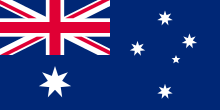
The Union Flag was found in the canton (upper left-hand quarter) of the flags of many colonies of Britain, while the field (background) of their flags was the colour of the naval ensign flown by the particular Royal Navy squadron that patrolled that region of the world. Nations and colonies that have used the Union Flag at some stage have included Aden, Barbados, Borneo, Burma, Canada, Ceylon, Cyprus, British East Africa (Kenya Colony), Gambia, Gold Coast (Ghana), Hong Kong, Jamaica, Lagos, Malta, Mauritius, Nigeria, Palestine, Penang (Malaysia), Rhodesia, Sierra Leone, Singapore, Somaliland, South Asia ( SAARC), Tanganyika, Trinidad, Uganda, and the United States. As former British Empire nations were granted independence, these and other versions of the Union Flag were decommissioned. The most recent decommissioning of the Union Flag came on 1 July 1997, when the former Dependent Territory of Hong Kong was handed over to the People's Republic of China.
All administrative regions and territories of the United Kingdom fly the Union Flag in some form, with the exception of Gibraltar (other than the government ensign) and the Crown Dependencies. Outside the UK, the Union Flag is usually part of a special ensign in which it is placed in the upper left hand corner of a blue field, with a signifying crest in the bottom right.
Four former British colonies in Oceania which are now independent countries incorporate the Union Flag as part of their national flags: Australia, New Zealand, Tuvalu and Fiji, the last of which is not part of the Commonwealth realms.
In former British colonies, the Union Flag was used semi-interchangeably with territorial flags for significant parts of their early history. This was the case in Canada until the introduction of the Maple Leaf Flag in 1965, but it is still used in the flags of a number of Canadian provinces such as British Columbia, Manitoba and Ontario. Newfoundland and Labrador uses a modified version of the Union Flag, once the flag of the province. Canadian practice allows the flag, known in Canada as the Royal Union Flag, to be flown by private individuals and government agencies to show support for the Monarch and the Commonwealth. On some official occasions, the flag is always flown besides the Maple Leaf Flag, one such occasion is on the anniversary of the Statute of Westminster.
Many Australian flags retain the use of the Union Flag, including the Royal Australian Navy Ensign (also known as the Australian White Ensign), the Royal Australian Air Force Ensign, the Australian Red Ensign (for use by merchant and private vessels) and the Australian Civil Aviation Ensign. The flags of all six Australian States retain the Union Flag in the canton, as do some regional flags such as the Upper and Lower Murray River Flags. The Vice-Regal flags of the State Governors also retain the use of the Union Flag.
The Basque Country's flag, the Ikurriña, is also loosely based on the Union Flag, reflecting the significant commercial ties between Bilbao and Britain at the time the Ikurriña was designed in 1894. The Miskito people sometimes use a similar flag that also incorporates the Union Flag in its canton, due to long periods of contact in the Mosquito Coast.
The Union Flag was used by the United States in its first flag, the Grand Union Flag. This flag was of a similar design to the one used by the British East India Company. Hawaii, a state of the United States but located in Oceania, incorporates the Union Jack in its state flag. According to one story, the King of Hawaii asked the British mariner, George Vancouver, during a stop in Lahaina, what the piece of cloth flying from his ship was. Vancouver replied that it represented his king's authority. The Hawaiian king then adopted and flew the flag as a symbol of his own royal authority not recognising its national derivation. Hawaii's flag represents the only current use of the Union Jack in any American state flag.
Also in the United States, the Union Flag of 1606 is incorporated into the flag of Baton Rouge, the capital city of Louisiana. Baton Rouge was a British colony from the time of the Seven Years' War until the end of the American Revolutionary War, when it was captured by Spanish and American forces. Symbols from the colonial powers France and Spain are also incorporated into the Baton Rouge flag. Taunton, Massachusetts, USA, has in recent years used a flag with the old style Union Flag. Likewise, Westmoreland County, Pennsylvania, has been known to fly a flag containing the King's Colours since 1973.
The Union Flag also appeared on both the 1910–1928 and 1928–1994 flags of South Africa. The 1910–1928 flag was a red ensign with the Union coat of arms in the fly. The 1928–1994 flag, based on the Prinsenvlag and commonly known as the oranje-blanje-blou (orange-white-blue), contained the Union Flag as part of a central motif at par with the flags of the two Boer republics of the Orange Free State and Transvaal. To keep any one of the three flags from having precedence, the Union Flag is spread horizontally from the Orange Free State flag towards the hoist; closest to the hoist, it is in the superior position but since it is reversed it does not precede the other flags.
The coat of arms of the Chilean city of Coquimbo features the Union Flag, owing to its historical commercial links to Britain.
|
Ensigns
The Union Flag can be found in the canton of several of the ensigns flown by vessels and aircraft of the United Kingdom and its overseas territories. These are used in cases where it is illegal to fly the Union Flag, such as at sea from a ship other than a British warship. Normal practice for UK ships is to fly the White ensign (Royal Navy) or the Red ensign (Merchant and private boats). Similar ensigns are used by other countries (such as New Zealand and Australia) with the Union Flag in the canton. Other countries (such as India and Jamaica) follow similar ensign etiquette as the UK, replacing the Union Flag with their own national flag.
|
Pilot or Civil Jack
The flag in a white border occasionally seen on merchant ships was sometimes referred to as the Pilot Jack. It can be traced back to 1823 when it was created as a signal flag, never intended as a civil jack. A book issued to British consuls in 1855 states that the white bordered Union Flag is to be hoisted for a pilot. Although there was some ambiguity regarding the legality of it being flown for any other purpose on civilian vessels, its use as an ensign or jack was established well in advance of the 1864 Act that designated the Red Ensign for merchant shipping. In 1970, the white-bordered Union Flag ceased to be the signal for a pilot, but references to it as national colours were not removed from the current Merchant Shipping Act and it was legally interpreted as a flag that could be flown on a merchant ship, as a jack if desired. This status was confirmed to an extent by the Merchant Shipping (Registration, etc.) Act 1993 and the consolidating Merchant Shipping Act 1995 which, in Section 4, Subsection 1, prohibits the use of any distinctive national colours or those used or resembling flags or pendants on Her Majesty's Ships, "except the Red Ensign, the Union flag (commonly known as the Union Jack) with a white border", and some other exceptions permitted elsewhere in the Acts. However, Section 2 regards the 'British flag', and states that "The flag which every British ship is entitled to fly is the Red Ensign (without any defacement or modification) and, subject to (a warrant from Her Majesty or from the Secretary of State, or an Order of Council from her Majesty regarding a defaced Red Ensign), no other colours." The ultimate determination of legality, however, is that many civil vessels routinely fly the white bordered Union Flag without official opposition, making it the de facto Civil Jack.
Other
The Hudson's Bay Company was one of a few non-government institutions using the Union Jack in part of the flag. HBC rival North West Company had a similar flag as well. The HBC jack is no longer in use and replaced with a corporate flag featuring the company's coat of arms.
Flag days
- United Kingdom
In July 2007, the British prime minister at the time, Gordon Brown, unveiled plans to have the Union Flag flown more often from government buildings. While consultation on new guidelines is under way, the decision to fly the flag may be made by each government department.
Previously the flag was generally only flown on public buildings on days marking the birthdays of members of the Royal Family, the wedding anniversary of the monarch, Commonwealth Day, Accession Day, Coronation Day, the Queen's Official Birthday, Remembrance Sunday and on the days of the State Opening and prorogation of Parliament. The Union Flag is flown at half mast from the announcement of the death of the Sovereign (save for Proclamation Day), or upon command of the Sovereign.
The current flag days where the Union Flag should be flown from government buildings throughout the UK are:
- 9 January (Birthday of The Duchess of Cambridge)
- 20 January (Birthday of The Countess of Wessex)
- 6 February (Anniversary of the accession of The Queen)
- 19 February (Birthday of The Duke of York)
- Second Monday in March ( Commonwealth Day)
- 10 March (Birthday of The Earl of Wessex)
- 21 April (The Queen's Birthday)
- 9 May ( Europe Day)
- 2 June (Anniversary of The Queen's coronation)
- 10 June (Birthday of The Duke of Edinburgh)
- June (no fixed date) – The Queen's Official Birthday
- 21 June (Birthday of The Duke of Cambridge)
- 17 July (Birthday of The Duchess of Cornwall)
- 15 August (Birthday of the The Princess Royal)
- Second Sunday in November ( Remembrance Sunday)
- 14 November (Birthday of The Prince of Wales)
- 20 November (Anniversary of the wedding of The Queen and The Duke of Edinburgh)
In addition, the Union Flag should be flown in the following areas on specified days:
- 1 March (Wales only, for St David's Day)
- 17 March (Northern Ireland only, for St Patrick's Day)
- 23 April (England only, for St George's Day)
- 3 September (Scotland only, for Merchant Navy Day)
- The Day of the Opening of a Session of the Houses of Parliament, Greater London only
- The day of the prorogation of a Session of the Houses of Parliament, Greater London only .
On 30 November, ( St Andrew's Day), the Union Flag can be flown in Scotland only where a building has more than one flagpole—on this day the Saltire will not be lowered to make way for the Union Flag if there is only one flagpole. This difference arose after Members of the Scottish Parliament complained that Scotland was the only country in the world that could not fly its national flag on its national day. However, on 23 April, St George's Day, it is the Union Flag of the United Kingdom that is flown over United Kingdom's government offices in England.
Non-government organisations may fly the Union Flag whenever they choose.
- Canada
In Canada, the Royal Union Flag is flown from federal buildings, airports, warships, military bases, and other government buildings on the following days:
- Commonwealth Day (second Monday in March)
- Victoria Day—the official birthday of the monarch (the Monday on or preceding 24 May)
- 11 December—the anniversary of the proclamation of the Statute of Westminster 1931
The flag is only flown in addition to the Canadian national flag, where physical arrangements allow (e.g., when there is more than one flag pole).
Usage and disposal
In general, there are no prescriptions regarding the use and disposal of the flag in a manner akin to the United States Flag Code. This reflects its largely unofficial status as a national flag. There is no contemporary national concept of flag desecration. There is also no specific way in which the Union Flag should be folded as there is with the United States Flag. It should simply be folded ready for the next use.
Royal Navy Stores Duties Instructions, article 447, dated 26 February 1914, specified that flags condemned from further service use were to be torn up into small pieces and disposed of as rags (ADM 1/8369/56), not to be used for decoration or sold. The exception was flags that had flown in action: these could be framed and kept on board, or transferred to a "suitable place", such as a museum (ADM 1/8567/245).
Other names
- In Canada the flag is officially called the Royal Union Flag.
- In Hong Kong, the flag has the nickname Rice-Character Flag (米字旗; Cantonese Jyutping: mai5zi6kei4) in Chinese, since the pattern looks like the Chinese character for "rice" (米).
- The Butcher's Apron is a pejorative term for the flag, common among Irish republicans, referring to atrocities committed in Ireland and other countries under British colonial rule. In 2006, Sandra White, a Member of the Scottish Parliament, caused a furore when the term was used in a press release under her name. It was later blamed on the actions of a researcher, who resigned yet claimed that the comment had been approved by White.
Other uses
Commonly the Union Flag is used on computer software and Internet pages as an icon representing a choice of the English language where a choice among multiple languages may be presented to the user. The Union flag has been embroidered on various Reebok equipment as a mark of the brand's British origin, and the Reebok Union Jack has been referred to as a brand icon. Many music artists have used the Union flag ranging from rock artists The Who, Freddie Mercury, Morrissey, Oasis, Iron Maiden and Def Leppard, to the pop girl group the Spice Girls.

